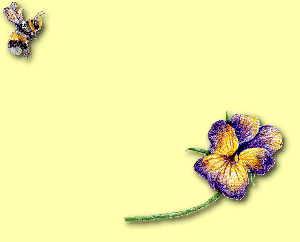 |
  |
 |
 Found in this garden is the Common Bumblebee (Bomubus americanus), who is found in nearly all land habitats including the Artic on the North American continent. He is a large hairy bee, usually yellow and black (sometimes with rust). He is about 1/2 inch to 1 1/8 inches long. This little guy is preferable to the Carpenter bee (Xylocopa virginica), who will bore holes deeply into wood (like my house). I think this is due to the fact that "loco" is in his name of Xylocopa! (Well maybe...) But he is a destructive little fellow. He is smaller at 1/8 inch to 1 inch long. The Carpenter bee is sparsely haired with metallic black and a narrower waist. Bees and wasps are distinguished from flies by having two pairs of wings. Bees in general have one of the most elaborate social organization in the animal world. Hundreds even thousands live in a communal nest, each with a task to perform. There is the queen who lays the eggs, the drones which impregnate the queen, and the workers who gather, make and store food for the adults and the larvae. Bees are the most important pollinating insects. They are dependent on pollen as a protein source and on flower nectar or oils as an energy source. Adult females collect pollen primarily to feed their larvae. The pollen they inevitably lose in going from flower to flower is important to plants because some pollen lands on the pistils (reproductive structures) of other flowers of the same species, resulting in cross-pollination. So when you see a bee, leave him alone to do his job, and he will leave you some beautiful flowers in the spring. makes the whole world kin" ---William Shakespeare 
References

Home Site Map Email at: dh @ naturehaven.com (Take out the spaces and this email address will work!) Please Read Guestbook ~~~ Please Sign Guestbook  |